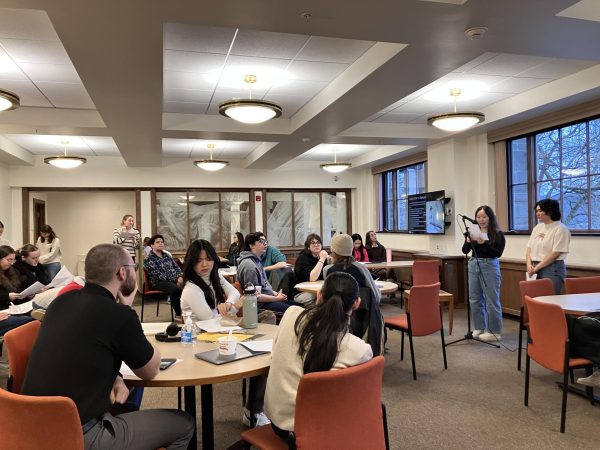It’s Called the Sugarplum:
In one particularly moving moment of It’s Called the Sugarplum, bereaved artist Joanna Dibble says that all she wants is “simplicity, like candy and fruit.”
Coincidentally, a wonderful simplic-ity is exactly what senior Ela Dugan and sophomore Ben Krempley, Sugarplum’s two actors, achieved.
From the one-room set to the cast of characters (only two!), Sugarplum oper-ated on the timeless principle of “less is more.” The play’s location in a Lathrop Hall basement storage-room (demarcated by handwritten signs heralding, “PLAY”) could only be described as unassuming and simple. Yet, the small storage-room effectively created a cozy atmosphere that reflected the intimacy of the play.
Set in a cramped bedroom, Sugarplum tells the story of two people struggling with guilt and blame in the wake of trag-edy and the unexpected places where love can blossom. Joanna Dibble (played by Dugan), distraught after losing her fian-c?e in a motor vehicle accident, confronts the man responsible for his death: Wal-lace Zuckerman (played by Krempley), the Harvard student who was driving the car. Despite reports asserting that the accident was “in no way Zuckerman’s fault,” Dibble cannot accept that he is blameless. The play centers around their confrontation in Zuckerman’s apartment and their relationship’s gradual trans-formation from hostility to kinship and eventually to love.
From Dibble’s initial tirade, wherein she enters Zuckerman’s apartment, crying out “Killer! Murderer!” I was hooked. Du-gan managed to not only contort her face into a convincing portrait of anguish, but to lace her every word with loathing. Her impassioned accusations were set off per-fectly by Zuckerman’s sincere apologies, followed by emotional protestations of in-nocence, that Krempley managed to make both remorseful yet indignant.
After their initially venomous argument, the story shifts once again. The two begin to realize that their supposed opponent is ac-tually a captivating, and compatible, other half. They bond while discussing everything from the “primitive and beautiful” handling of meat to the proper way of Zen medita-tion. Each subject they delve into is unique-ly comical, like Zuckerman’s insistence that there are no two words more beautiful than “cellar door,” and Dibble’s fervent agree-ment. Not only could Dugan and Krempley pull off distressed, they even made hilarious work, too.
But naturally, such a perfected give-and-take required some not-so-simple preparation. Auditions took place in early February and, because the play served as Dugan’s senior capstone, she was the one who chose Krempley as her Zuckerman. Rehearsals three times per week began almost immediately after.
As it was Dugan’s capstone, not only was casting up to her discretion, but so was the play itself. So why did she choose Sugarplum?
“I was drawn to it because it was about college age students…it took place in the 60s, so I also wanted to adapt it in a modern sense,” Dugan said. “It’s really a quirky, fun play.”
For guidance, Dugan had Visiting Assistant Professor of English in the University Theater Simona Giurgea serve as her director.
“It was really more a teaching job for me than directorial project because I didn’t choose it myself. My directing was really accepting to be the outside eye… to help find the common language and truths of the play,” Giurgea said.
“Working with Simona has been a slightly terrifying, but incredibly enlight-ening experience,” Dugan joked. “It is amazing to see how intuitive her directing sense is and I can’t thank her enough for continually pushing me.”
Not only did the play have all the in-gredients of a successful show, they had the treats that go along with it. After the performance, mingling students helped themselves to homemade sugarplums. Yes, less may be more – except when it came to those fruity treats!
Contact Maggie Grove at






